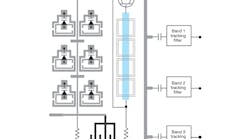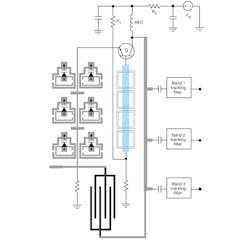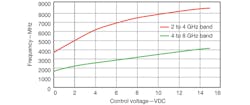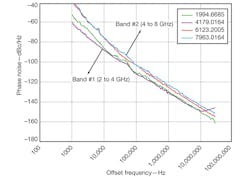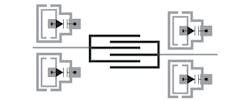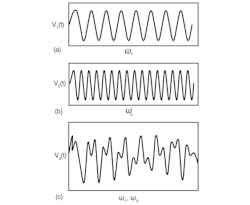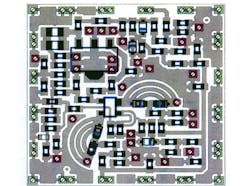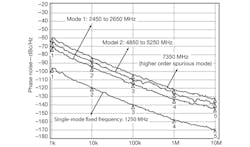Oscillators are critical to modern communications. They must provide clean, reliable signals for tuning radios, with repeatable tuning, but without consuming too much power. Oscillator designers are now being asked to do more for less, as more functions and frequency bands are being packed into electronic communications products such as cellular telephones and wireless-local-area-network (WLAN) devices. Next-generation wireless communications ideally will offer the frequency agility to cover multiple frequency bands and communications standards. This can be accomplished using multiple oscillators, each with their own frequency tuning ranges.
Alternately, as the source designers at Synergy Microwave Corp. have discovered, it is possible to construct a single reconfigurable concurrent oscillator (RCO) with the frequency coverage of several voltage-controlled oscillators (VCOs). Synergy’s RCOs can support several radio bands (Fig. 1). They provide the performance of separate tunable oscillators with significantly reduced size and power consumption compared to separate oscillators, for use in multiple-band, multimode wireless communications systems.
1. This reconfigurable concurrent oscillator (RCO) can produce multiple signals for multiple radio bands.
Related Articles
• Optimize Varactor-Tuned Oscillators
• Get A Handle On Oscillator Phase Noise And Jitter
• YIG Oscillators Fit Surface-Mount Packs
Efforts to miniaturize wireless communications hardware have led to compact radio designs with tunable oscillators, such as VCOs, to cover a number of different frequency bands. However, tunable oscillators typically exhibit tradeoffs between phase-noise performance and power consumption. Attempts to develop multiband VCOs with low phase noise often yield large, power-hungry circuits. Numerous techniques take aim at compact source solutions for multiple-band radio designs, including switching among separate VCOs, using intermodal multiple-frequency circuits, or switching among multiple resonators. But they are inevitably large, or power hungry, or demonstrate poor phase noise.1-27
For example, switched resonators suffer from the resistive and capacitive parasitic circuit elements associated with the switches. Mode switching has been used to select among multiple oscillation modes of resonant circuits; it is utilized in ways that the losses and nonlinearities of the switches do not impact the steady-state and phase-noise performance of the resonators. But this approach does not involve concurrent generation of signals, and is limited in terms of achieving reduced source size, power consumption, and design cycle time. Traditional band-select sources have incorporated multiple resonators, VCOs, or other tunable oscillators, but any band-selection switch inevitably degrades the performance of this type of multiband source.
2. The RCO source approach can be used when multiple concurrent signals are needed, such as from 2 to 4 GHz and from 4 to 8 GHz.
In Synergy Microwave Corp.’s new approach, multiple-band signals are generated concurrently, available for use as needed (Fig. 2). This new class of oscillator (Fig. 1) uses higher-order multicoupled planar resonators (MCPRs) to synchronously generate different frequencies for different bands (and different applications). It works without multipliers or switching from among resonators and/or oscillators. This allows for reduced complexity, size, and power consumption compared to other multiple-signal-generation methods, as well as for excellent phase-noise performance (Fig. 3).
3. The multiple-signal oscillator approach cuts power consumption and size without sacrificing phase-noise performance.
What kind of communications device can benefit from such a multiple-signal source? WLANs are among the most popular of wireless applications in home and office environments, operating within different frequency bands—notably, within the Industrial-Scientific-Medical (ISM) band from 2.40 to 2.50 GHz and various bands from 5.15 to 5.85 GHz. A WLAN radio capable of operating within both bands might work with switchable VCOs, although a more fully integrated multimode radio design would be based on a single signal source capable of covering both bands, such as an RCO.
The basic principle of a multimode radio is to process two or more signals of differing frequencies at the same time, using only one transmit/receive signal-processing chain. Figure 4 shows a frequency plan for a dual-band, 2.4-GHz/5-GHz WLAN transceiver system.8 It is based on a single 8-GHz VCO with a divide-by-two divider in a frequency synthesizer to generate a 4-GHz signal. This is followed by divide-by-four divider to reach 1 GHz. These in-phase (I) and quadrature (Q) signals are mixed in a quadrature single-sideband (SSB) mixer to produce the 5-GHz signal which is further divided to obtain the 2.4-GHz signal.
4. This frequency plan produces multiple WLAN signals from a single 8-GHz VCO.
This approach requires multiple buffer, divider, and filter stages to produce signals for a dual-band WLAN radio. The multiple signals could also be generated by starting with lower-frequency signals and adding multipliers. But in cases where quadrature frequency converters are used, multiplication is rarely used for the final stage of frequency conversion, given the difficulty of working with differential outputs at higher frequencies.
Conventional single-output oscillators generate periodic waveforms, essentially a single frequency and its harmonic signal components. Tunable oscillators based on higher-order resonators can provide multiple modes of oscillation and can generate multiple, independent frequencies, either individually or simultaneously.14-16
A single-output tunable oscillator is a good starting place to design a multiple-band oscillator. A single-frequency tunable wideband oscillator incorporates a varactor-tuned second-order resonator network to generate a signal at a desired frequency. It employs an active device, such as a bipolar transistor, terminated in a parallel or series inductive-capacitive (LC) resonant-tuned circuit. A parallel LC resonator network exhibits a high parallel resistance (or anti-resonance), while a series LC resonator network provides a low series resistance (or resonance). Such a design will inevitably be limited by the capabilities of the transistor, the electrical contributions of its package, and the large change in capacitance needed to tune the oscillator over a broad frequency range.
A multimode, multiple-frequency oscillator will require more than a simple parallel LC network and an active device. An oscillator circuit that can produce two simultaneous frequencies must be capable of simultaneous negative resistance values at two distinct frequencies, and a higher-order resonator is needed for that purpose. The order of the resonator is dependent upon the number of different frequency signals/bands desired. Whereas a simple second-order resonator network produces one frequency, a fourth-order resonator network can produce two simultaneous frequencies.
The trick in designing such an oscillator is learning the values of negative resistance needed to support the multiple separate frequency bands, and this information can be found by performing network analysis. Such analysis contributed to the design of the multimode, multiple-frequency oscillator unveiled in Fig. 1. The patent-pending multiple-frequency oscillator incorporates metamaterial-based fourth-order resonators (Fig. 5).
5. The multiple-frequency oscillators employ higher-order, metamaterial-based resonators.
An oscillator with a high-order (<2) resonator can achieve multiple stable modes of oscillation and generate multiple resonant frequencies. With a suitable nonlinear active-circuit topology and the necessary resonator component values, a higher-order oscillator can provide more than one resonant frequency. For example, a tunable oscillator with fourth-order resonator can generate either or both distinct frequencies ω1 and ω2 together (Fig. 6). Such an oscillator can be assembled by synthesizing two inductors of different values at the base of an oscillator transistor, such as a bipolar transistor, to establish the conditions required for simultaneous sustained oscillation.
6. An oscillator with fourth-order resonators can generate multiple simultaneous output signals.
To validate the multiple-frequency oscillator concept, a prototype was assembled to generate two synchronous bands. The oscillator’s fourth-order resonators were realized by incorporating two parallel second-order resonators in the base of a bipolar transistor (Fig. 1). The RCO was designed with a layout (Fig. 7) that can be fabricated with standard integrated-circuit (IC) technologies, using higher-order metamaterial resonators for multiple-concurrent-frequency operation. It can be tuned across two different frequency bands, such as 2.45 to 2.65 GHz and 4.85 to 5.25 GHz, with a considerable reduction in power consumption and size compared to separate switched VCOs.
7. This layout was used in the fabrication of a prototype dual-frequency oscillator.
Intuitively, higher inductance values are needed for the lower-frequency oscillation range (2.45 to 2.65 GHz) than the higher-frequency mode (4.85 to 5.25 GHz). With the assistance of commercial computer-aided-engineering (CAE) software, different performance parameters, such as phase noise (Fig. 8), were simulated for the two-frequency oscillator. The required inductance values were synthesized by incorporating a tuning capacitor across the resonator network at the base of the bipolar transistor, achieved in such a way that the tuning capacitor provides the required negative resistance and reactance (inductive or capacitive) at the emitter terminal of the transistor over the operating bands of interest.
8. CAE software tools were helpful in simulating the performance parameters of the dual-frequency oscillator designs, such as this plot of phase-noise performance.
The filters employed in the multimode oscillator are meant to assist with mode leakage, such as when the oscillator circuit oscillates in dual modes. The amount of mode leakage from a given design will depend on the spectral selectivity of the succeeding filter for that portion of the circuit as well as the design requirements for the oscillator.
The phase noise of the fourth-order oscillator, when generating only one of its resonant frequencies, is comparable to the phase noise of a second-order oscillator using the same active topology and resonator quality factor (Q).
9. The measured phase noise of the prototype source is typically better than -120 dBc/Hz offset 1 MHz from either tuning range.
But compared to commonly used switched resonator oscillators, the fourth-order oscillator has better phase noise and/or higher tuning range in VCO implementations. The measured phase noise of the prototype source is typically better than -120 dBc/Hz offset 1 MHz from either carrier range (Fig. 9). The multiple-band oscillator requires only +5 VDC and 20 mA bias, and delivers +3 dBm typical output power over both frequency bands. For multimode, multiple-frequency-band wireless equipment, this one source may be the match of traditionally many VCOs.
Dr. Ulrich L. Rohde, Chairman
Dr. Ajay K. Poddar, Chief Scientist
Synergy Microwave Corp., 201 McLean Blvd., Paterson, NJ 07504; (973) 881-8800, e-mail: [email protected], www.synergymwave.com.
References
1. M. Tiebout, “A CMOS fully integrated 1 GHz and 2 GHz dual band VCO with a voltage controlled inductor,” in Proceeding of the IEEE European Solid-State Conference, 2002, pp. 799-802.
2. A. Goel and H. Hashrmi, “Frequency Switching in Dual-Resonance Oscillators,” IEEE Journal of Solid-State Circuits, Vol. 42, No. 3, March 2007.
3. U.L. Rohde, A.K. Poddar, and G. Boeck, Modern Microwave Oscillators for Wireless Applications: Theory and Optimization, Wiley, New York, 2005.
4. A.D. Berny, A.M. Niknejad, and R.G. Meyer, “A 1.8 GHz LC VCO with 1.3 GHz tuning range and digital amplitude calibration,” IEEE Journal of Solid-State Circuits, Vol. 40. No. 4, 2005, pp. 909-917.
5. “Low Noise, Low Power Consumption, Configurable, and Adaptable Ultrawideband VCOs,” 2006 IEEE International Conference on Ultrawideband (ICUWB 2006).
6. A. Bavisi, “Integrated Multi-Mode Oscillators and Filters For Multi-Bnad Radios Using Liquid Crystalline Polymer Based Packaging Technology,” Ph.D. thesis, Georgia Institute of Technology, Atlanta, GA, May 2006.
6. A. Ravi, B.R. Carlton, G. Banerjee, and K. Soumyanath, “A 1.4-V, 2.4/5.2-GHz, 90-nm CMOS system in a package transreceiver for next generation WLAN,” in IEEE Symposium On VLSI Technology, Digest of Technical Papers, IEEE, New York, 2005.
8. C. Lam and B. Razavi, “A 2.6/5.2 GHz frequency synthesizer in 0.4-μm CMOS technology,” in IEEE Journal of Solid-State Circuits, Vol. 35, May 2000, pp. 788-790.
9. B. Razavi, RF Microelectronics, Prentice-Hall, Englewood Cliffs, NJ, 1998, 2nd edition.
10. M-S Yim and K.K.O., “Switched resonators and their applications in a dual band monolithic CMOS LC tuned VCO,” IEEE Transactions on Microwave Theory & Techniques, Vol. 54, No. 1, January 2006, pp. 74-81.
11. B. Klepser, M. Punzenberger, T. Ruhlicke, and M. Zannoth, “5 GHz and 2.4 GHz dual-band RF-transreceiver for WLAN 802.11a/b/g applications,” in IEEE RFIC Symposium Digest Papers, 2003, pp. 37-40.
12. K. Araki, et al., “Implementation and performance of a multi-band wireless configuration,” 2004, pp. 207-210.
13. S. Wiggins, Introduction to Applied Nonlinear Dynamics and Chaos, Springer-Verlag, New York, 1997, 2nd edition.
14. B. van der Pol, “On oscillation hysteresis in a triode generator with two degree of freedom,” Philosophy Magazine, Vol. 43, 1922, pp. 700-719.
15. J.S. Schaffner, “Simultaneous oscillations in oscillators,” IRE Transactions on Circuit Theory, Vol. 1, No. 2, June 1954, pp. 2-8.
16. T. Endo and S. Mori, “Mode Analysis of a multimode ladder oscillator,” IEEE Transactions on Circuits & Systems, Vol. CAS-23, February 1976, pp. 100-113.
17. A.K. Poddar, “A Novel Approach for Designing Integrated Ultra Low Noise Microwave Wideband Voltage Controlled Oscillators,” Dr.-Ing. Dissertation, TU- Berlin, Germany, December 14, 2004.
18. U.L. Rohde, A.K. Poddar, and R. Rebel, “Integrated Low Noise Microwave Wideband Push- Push VCO,” United States Patent No. 7,088189, August 2006.
19. I. Bruyland, “Simultaneous oscillations at two frequencies in RLC circuits,” Proceedings of the IEEE, Vol. 1, January 1968, pp. 82-83.
20. A.K. Poddar, J.K. Bansal, and K.N. Pandey, “Millimeter Wave Evanescent Mode Power Combiner Gunn Oscillator in Suspended Stripline Configuration,” Mathematical Methods in Electromagnetic Theory, IEEE/MMET, June 1998, pp.384-386.
21. L. Zhenbiao and K.K.O, “A 1-V low phase noise multi-band CMOS voltage controlled oscillator with switched inductors and capacitors,” in IEEE RFIC Symposium Digest, 2004, pp. 467-470.
22. U. L. Rohde and A. K. Poddar, “Tunable Frequency, Low Phase Noise and Low Thermal Drift Oscillator,” United States Patent No.7196591, March 2007.
23. A.K. Poddar and K.N. Pandey, “Evanescent Mode Power Combiner in SSL Configuration,” High Performance Electron Devices for Microwave and Optoelectronic Application, 8th IEEE International Symposium, November 2000, pp. 196-201.
24. A.K. Poddar, S.K. Koul, and Bharthi Bhat, “Millimeter Wave Evanescent Mode Gunn Diode Oscillator in Suspended Stripline Configuration,” 22nd International Conference on Infrared and Millimeter-Wave Technology, July 1997, Symposium Digest, pp. 265-266.
25. U.L. Rohde and A.K. Poddar, “Wideband voltage controlled oscillators employing evanescent mode coupled resonators,” United States Patent No. 71803812, February 2007.
26. U.L. Rohde and A.K. Poddar, “Concurrent Oscillators For Multi-Band Wireless Communication Systems,” 20th IEEE CCECE 2007, British Columbia, Canada, April 22-26, 2007.
27. U.L. Rohde and A.K. Poddar, “Reconfigurable Concurrent Oscillators For Multi-Band Multi-Mode Wireless Communication Systems,”IEEE Sarnoff Symposium, Princeton, NJ, April 30-May 2 2007.
